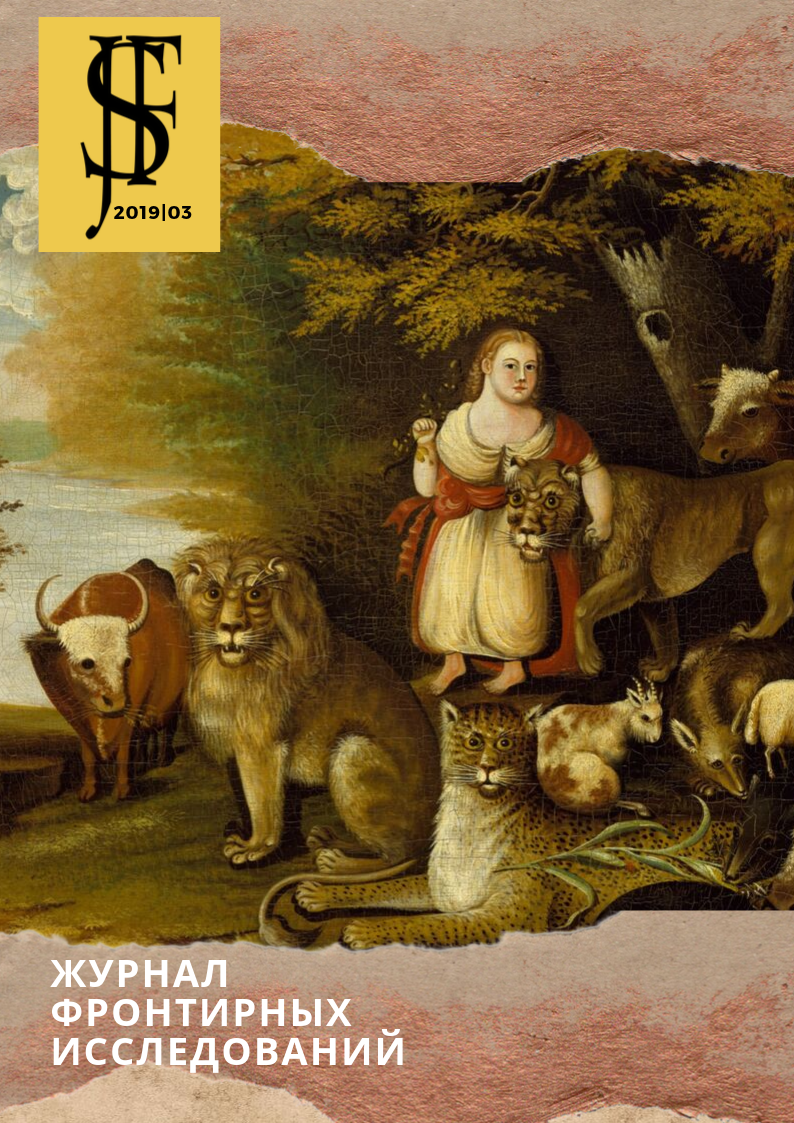Abstract
The attention of the author is focused on the problems associated with the penetration of a variety of trends to the territory of the frontier region that are opposed to the dominant religious denomination. Using the example of the Kuban Region and the Black Sea Governorate, the ways and means of the emergence and spread of religious dissent in the inherent sociocultural conditions are investigated. In this aspect, various groups of religious dissidents operating in the territory of the Kuban are considered: Dukhobors, Molokans, Christ-believers, Judaists, Baptists, Evangelical Christians, Adventists. It is noted that the position of the region under study as a frontier territory has left its mark on the spread of religious dissidence in it. This process took place against the background of constant interethnic and interfaith contacts, naturally increased migration flows, and a complicated system of social relations. The peculiarities of the region, which is a frontier between many cultural spaces, have prepared fertile ground for the spread of religious dissent here.
The doctrines of the Russian religious dissidence that extended to the Kuban during the studied period are divided into three groups depending on the time, ways and means of their appearance in the region in question. The followers of the religious teachings of the first group (Judaizers and Dukhobors) penetrated the Kuban in the 1830-1860s. from Central Russia and from the neighboring southern regions only through administrative relocation.
Adherents of religious movements belonging to the second group (Molokans, Christovans, Katasonians and eunuchs) settle in the region mainly in the post-reform period and often through voluntary migration. In the future, these doctrines are spread due to the active preaching of their followers, the sources of which were the neighboring Stavropol gubernia and the Transcaucasus.
Religious communities belonging to the third group were spread in the region mainly under the influence of religious agitation carried out by the most active adherents, often professionally engaged in preaching work (Lubkivtsy, Baptists, Adventists).
References
Alexey (Dorodnitsyn), bishop (1904). Shelaput community. Russian Gazette, 10, 704-710. (in Russian).
Astyrev, N. (1891). Cleaning up days from Russia and Siberia. Northern Herald, 6, 48-62. (in Russian).
Bayeva, L.V. (2014). Typology and problems of studying the South-Russian frontier. Bulletin of Volgograd State University, Ser. 7, Philosophy, 2 (22), 32-39. (in Russian).
Boyko, I.K. (2016). Garden of Arts peasants Mazaev. New historical perspectives, 3 (4), 31-42. (in Russian).
Valkevich, V.A. (1900). Note on the propaganda of Protestant sects in Russia and, especially, in the Caucasus: in 2 tons. Tiflis, V.1, 131-132. (in Russian).
GM [Mikhailovsky G.]. (1875). A sect of Jewish in the villages of Vysotsky, Medvedsky, Prosyanka and Grateful, Stavropol Province. Caucasian Diocesan Gazette, 6, 190-203. (in Russian).
State Archive of Krasnodar Region. (n.d.). F. 252. Op. 1. D. 1652. (in Russian).
State Archive of Krasnodar Region. (n.d.). F. 252. Op. 2. D. 1643. (in Russian).
State Archive of Krasnodar Region. (n.d.). F. 252. Op. 2. D. 1905. (in Russian).
State Archive of Krasnodar Region. (n.d.). F. 257. Op. 1. D. 2. (in Russian).
State Archive of Krasnodar Region. (n.d.). F. 418. Op. 1. D. 170. (in Russian).
State Archive of Krasnodar Region. (n.d.). F. 449. Op. 2. D. 1831. (in Russian).
State Archive of Krasnodar Region. (n.d.). F. 449. Op. 2. D. 1851. (in Russian).
State Archive of Krasnodar Region. (n.d.). F. 449. Op. 3. D. 144. (in Russian).
State Archive of Krasnodar Region. (n.d.). F. 454. Op. 1. D. 5298. (in Russian).
State Archive of Krasnodar Region. (n.d.). F. 454. Op. 2. D. 5223. (in Russian).
State Archive of Krasnodar Region. (n.d.). F. 454. Op. 2. D. 779. (in Russian).
State Archive of Krasnodar Region. (n.d.). F. 454. Op. 2. D. 916. (in Russian).
State Archive of Krasnodar Region. (n.d.). F. 454. Op. 4. D. 77. (in Russian).
State Archive of Krasnodar Region. (n.d.). F. 583. Op. 1. D. 1043. (in Russian).
State Archive of Krasnodar Region. (n.d.). F. 764. Op. 1. D. 69. (in Russian).
State Archive of the Stavropol Region (n.d.). F. 135. Op. 18. D.422. (in Russian).
Klibanov, A.I. (1965). The history of religious sectarianism in Russia (the 60s of the XIX century - 1917). Moscow: Science. (in Russian).
Criticism of religious sectarianism. (1974). Moscow: Thought. (in Russian).
Lyausheva, S.A. (2002). The evolution of the religious beliefs of the Circassians: history and modernity (philosophical and culturological analysis). Rostov-on-Don: Publishing House SKNTS VS., Pp. 85-86. (in Russian).
Maksimov, I. (1887). Something about Adventism. Stavropol Diocesan Gazette, 15, 1120-1124. (in Russian).
Melnikov, PI (Andrey Pechersky) (1974). Collected Works (Vols. 1-8). Moscow: Pravda. (in Russian).
Lesser in my brotherhood. (1887). A few words about Baptists in the Kuban region. Stavropol Diocesan Gazette, 15, 560-564. (in Russian).
The main administrative and territorial changes in the Kuban (1793-1985). (1986). Krasnodar: Krasnodar publishing house. (in Russian).
Ostapenko, R. A. (2019). Elements of Christianity in the culture of the Circassians according to ethnographic, linguistic and archaeological sources. Heritage of Centuries, 1, 78–97. Retrieved from http://heritage-magazine.com/wp-content/uploads/2019/03/2019_1_Ostapenko.pdf (appeal date dd.mm.yyy) (in Russian).
Report of the Chief of the Kuban Region and the ataman of the Kuban Cossack Army on the state of the region and the army for 1900 (1901). Ekaterinodar: Typography of Kuban region Office. (in Russian).
Report on the activities of the diocesan antisectant missionary priest. S. Nikolsky in 1897 (1901). Stavropol Diocesan Gazette. 1901, 14, 645-664. (in Russian).
Report on the activities of the diocesan antisectant missionary priest. S. Nikolsky in 1897 (1901). Stavropol Diocesan Gazette, 9, 463-476. (in Russian).
Russian State Historical Archive. (n.d.). F.796. Op.190. Sec.6. Article 3 D.146a. L. 202. (in Russian).
Simonov A. (1996). Hera and subbotnik Kuban in the description of an anonymous Rostov Zionist (autumn 1917). Herald of the Hebrew University in Moscow, 1996, 1 (17), 196-197. (in Russian).
Trekhbratov B.A. (Ed.) Encyclopedic dictionary on the history of the Kuban. (1997). Krasnodar: Edvi. (in Russian).

This work is licensed under a Creative Commons Attribution-NonCommercial-NoDerivatives 4.0 International License.

